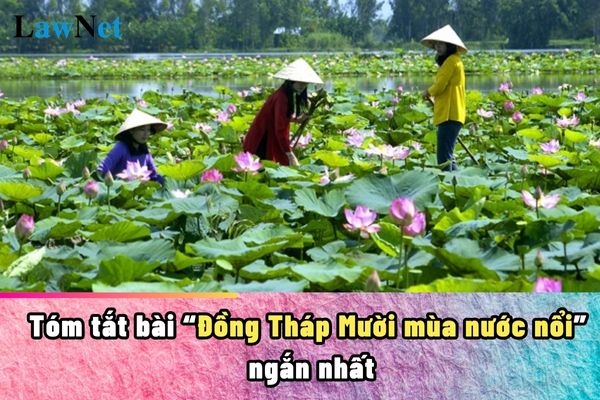What is the summary for the lesson "Đồng Tháp Mười mùa nước nổi" for students in Vietnam? What rhetorical devices do grade 6 students in Vietnam learn?
What is the summary for the lesson "Đồng Tháp Mười mùa nước nổi" for students in Vietnam?
The text "Đồng Tháp Mười mùa nước nổi" by Poet Văn Công Hùng is one of the subjects that students will learn in the literature program.
Students can refer to the following summary of the "Đồng Tháp Mười mùa nước nổi" text:
|
Summary for the lesson "Đồng Tháp Mười mùa nước nổi" Đồng Tháp Mười and the Flood Season: |
Note: The information only serves as reference./.

What is the summary for the lesson "Đồng Tháp Mười mùa nước nổi" for students in Vietnam? What rhetorical devices do grade 6 students in Vietnam learn? (Image from the Internet)
What rhetorical devices do grade 6 students in Vietnam learn?
Based on sub-section 2, Section 5 of the Literature Curriculum in the General Education Program issued with Circular 32/2018/TT-BGDDT, grade 6 students are introduced to the following Vietnamese knowledge content:
- Simple words, compound words, compound nouns, and derivative words
- Multimeaning and homonymous words
- Meaning of some common idioms
- Meaning of some common Sino-Vietnamese elements (e.g., bất, phi) and words containing those elements (e.g., injustice, disagreement, illogical, absurd)
- The main components of a sentence: Expand the main components of a sentence with a phrase
- Adverbials: Features, functions in linking sentences
- Uses of semicolons (mark boundaries between complex series); quotation marks (indicate understanding of a word not in the usual sense)
- Rhetorical devices of metaphor, metonymy: Features and effects
- Paragraphs and texts: Features and functions
- Select vocabulary and some sentence structures suitable for expressing the meaning of the text
- Document styles and genres
+ Narrative text: Narratives of personal experiences, narratives of a folk tale
+ Descriptive text: A text describing a living scene
+ Expressive text: Lục bát poetry; a paragraph capturing emotions when reading lục bát poetry
+ Argumentative text: Opinions, reasoning, evidence; presentations on an educational or life phenomenon
+ Informative text: Title, teaser, heading, bold text, numbering, and bullet points; an explanatory text narrating an event; record of an incident or a meeting, discussion
- Language development: Phenomena of borrowing words and using borrowed words
- Non-verbal communication means: images, statistics
There are two rhetorical devices students learn in 6th grade: metaphorical and metonymic rhetorical devices.
What are some other literary knowledge for the grade 6 Literature subject in Vietnam?
According to sub-section 2, Section 5 of the General Education Literature Program issued with Circular 32/2018/TT-BGDDT, other literary knowledge for grade 6 Literature includes:
- Expressiveness of literary texts
- Details and relationships between details in literary texts
- Themes and topics of texts; feelings and emotions of the writer
- Elements: plot, characters, narrator's voice, and character speech in legends, fairy tales, fables
- First-person and third-person narrators
- Formal elements of lục bát poetry: Number of sounds, lines, rhymes, rhythm
- Titles, lines of poetry, stanzas, rhyme, rhythm, words, and effects of these elements in poetry
- Narrative, descriptive elements in poetry
- Recording forms, storytelling methods, first-person narrators in memoirs or travelogues
Additionally, the materials used in the grade 6 Literature subject include:
(1) Literary text
- Legends, fairy tales, fables, short stories
- Poetry, lục bát poetry
- Memoirs or travelogues
(2) Argumentative text
- Social argumentative essays
- Literary argumentative essays
(3) Informative text
- Texts recounting an event
- Meeting minutes
- Content summary diagrams.

